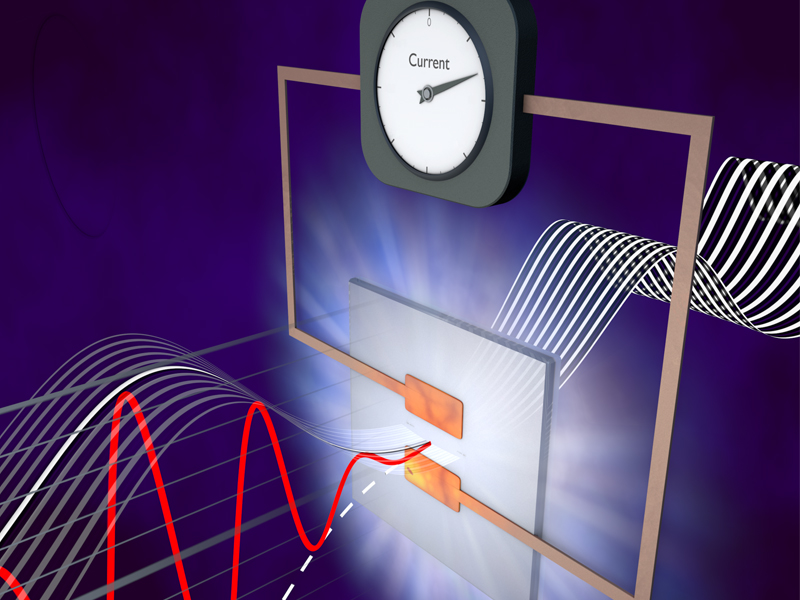
Boosting Digital Performance with Engineered Light Innovations

A semiconductor connected to metal electrodes is exposed to an ultra-short laser pulse, generating and steering directly measurable electric currents.
Graphic: Christian Hackenberger
Modern electronics and digital technologies rely on the control of electric current in semiconductor devices, from computers to smartphones and amplifiers. An international study by scientists from Monash University (Melbourne, Australia) and the Max Planck Institute of Quantum Optics (Garching, Germany) lays foundations for a dramatic performance increase of semiconductor-based signal-processing technologies. (Optica, 14 November 2016, DOI: 10.1364/OPTICA.3.001358).
The work, published in Optica, found that electric current can be turned on and off in a semiconductor (gallium nitride in this case) at unprecedented speeds by using engineered light as a means of control. These findings pave the way for the design of optically controlled semiconductor electronic devices that can operate at frequencies much larger than those demonstrated until now.
“The time it takes to switch electric current on and off in a semiconductor, determines the rate at which electronic devices can perform. We found that by using few-cycles laser pulses with engineered optical field waveforms – which are the fastest tools available to researchers – electric current can be controlled in a semiconductor at rates thousands of times higher than those achieved in state-of-the-art electronics,” said Monash researcher and ARC Future Fellow, Dr. Agustin Schiffrin, the lead investigator of the study.
“We successfully investigated how these devices operate in various regimes by comparing the circuits with two different materials: gallium nitride and fused silica. In both cases, laser field induces interference of electronic excitations and allows controlling them on a femtosecond timescale. Our current setup performs at much lower field intensities than those required for dielectrics, so it can work even with non-amplified laser pulse sources,” said Dr. Stanislav Kruchinin, a researcher from MPQ.
This work showcases the fastest control of electric currents ever measured in a semiconductor, opening the door to the design of novel optically controlled electronics.
Original publication:
T. Paasch-Colberg, S. Yu. Kruchinin, Ö. Sağlam, S. Kapser, S. Cabrini, S. Muehlbrandt, J. Reichert, J. V. Barth, R. Ernstorfer, R. Kienberger, V. S. Yakovlev, N. Karpowicz and Agustin Schiffrin
Sub-cycle optical control of current in a semiconductor: from the multiphoton to the tunneling regime
Optica, 14 November 2016, DOI: 10.1364/OPTICA.3.001358
Contact:
Dr. Olivia Meyer-Streng
Press & Public Relations
Max Planck Institute of Quantum Optics, Garching, Germany
Phone: +49 (0)89 32 905 -213
E-mail: olivia.meyer-streng@mpq.mpg.de
Silvia Dropulich
Marketing and Communications Manager
Monash University, Melbourne, Australia
Phone: +61 3 9902 4513
E-mail: silvia.dropulich@monash.edu












